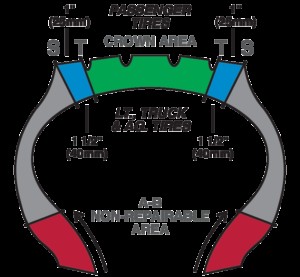Dealing with a flat tire is a common автомобилист inconvenience, often leaving drivers searching for the quickest fix to get back on the road. While temporary solutions like tire plugs and strings might seem appealing in an emergency, understanding the proper way to repair a punctured car tire is crucial for your safety and the longevity of your tire. This guide will walk you through the industry-recommended process for repairing a punctured tire, ensuring a safe and lasting solution.
Why Temporary Tire Repairs Like Plugs and Strings Are Risky
It’s a common misconception that if a tire plug or string stops the leak, the tire is safely repaired. While these methods might temporarily reinflate your tire, they are not designed as permanent fixes. The primary issue with plug and string repairs is that they often fail to completely seal the puncture injury. This incomplete seal allows air and, more critically, moisture to penetrate the inner structure of the tire. Over time, this moisture can lead to corrosion of steel belts and weakening of the tire’s internal components, significantly increasing the risk of a dangerous tire blowout. These types of repairs are strictly intended as a temporary measure to get you to a professional repair shop, not for long-term use.
Patch-Only Repairs: Another Inadequate Solution
Another shortcut that compromises tire safety is relying solely on a patch applied to the inner liner of the tire. Similar to plug-only repairs, a patch alone, while effectively sealing air from escaping, does not address the puncture channel itself. Consequently, the same problem arises: moisture and contaminants can still enter the tire through the unsealed puncture hole from the outside. This can lead to hidden damage within the tire’s structure, potentially causing premature tire failure and safety hazards down the line.
The Industry-Standard Method for Punctured Tire Repair
The only way to ensure a safe and durable repair for a punctured tire is through a combination patch and plug method. This process, adhering to industry best practices, completely seals the puncture from the inside out, filling the injury channel and preventing any ingress of moisture or debris. To help remember the steps involved in a proper tire repair, we use the acronym R.E.P.A.I.R.:
Step-by-Step Guide: The R.E.P.A.I.R. Acronym
-
Remove: The first and essential step is to remove the tire from the wheel assembly. This is necessary to conduct a thorough inspection of both the interior and exterior of the tire for damage assessment.
-
Evaluate: With the tire removed from the rim, a detailed evaluation of the puncture can be performed. This includes determining the size, direction, and angle of the puncture. Crucially, this step also involves checking for any internal damage to the tire’s cords or belts caused by the puncturing object or by driving on a flat tire.
-
Prepare: If the tire is deemed repairable after evaluation, the preparation stage begins. This involves using a carbide cutter to carefully drill out the puncture channel. This process removes any damaged cords, debris, and irregular surfaces within the injury path, preparing it for a complete and robust seal. Additionally, the inner liner around the puncture area is cleaned and buffed to create a slightly rough texture. This roughened surface is vital for maximizing the adhesion of the repair unit.
-
Apply: Vulcanizing fluid is then applied to both the prepared puncture channel and the buffed area on the inner liner. This fluid is crucial as it initiates the chemical bonding process between the tire rubber and the repair unit. The vulcanizing fluid needs to air dry for approximately 5 to 10 minutes to become tacky, ensuring optimal adhesion.
-
Install: The next step involves installing a combination patch-plug repair unit. The plug portion is inserted through the prepared injury channel from the inside of the tire, filling the puncture. Simultaneously, the patch portion is applied to the buffed inner liner area. Using a tire stitcher, the patch is then thoroughly stitched down, working from the center outwards to eliminate any trapped air bubbles and ensure complete contact and adhesion to the inner liner. After stitching, the excess plug material protruding from the tire’s tread is trimmed to about ¼” above the surface. Finally, the repaired area on the inner liner is coated with a thin layer of rubber sealant for an extra layer of protection.
-
Return to Service: The final step is to remount the repaired tire back onto the wheel rim. The tire should then be properly inflated to the recommended pressure, balanced to ensure smooth driving, and finally, the wheel is remounted back onto the vehicle. The tire is now ready to safely return to service.
When Can a Punctured Tire Be Safely Repaired?
 the repairable are of most tires is restricted to the crown
the repairable are of most tires is restricted to the crown
Not every punctured tire is suitable for repair. Several factors determine whether a tire can be safely repaired, primarily falling into three categories:
Location of the Puncture
For passenger car tires, repairs are only considered safe if the puncture is located within the crown area of the tire. The crown is the central tread area, between the shoulder and shoulder. Damage to the tire’s shoulder or sidewall is generally not repairable due to the flexing and stress these areas endure during normal operation. Attempting to repair punctures in these regions can lead to repair failure and tire instability.
Size of the Puncture
The size of the puncture also plays a critical role in determining repairability. For standard fabric-ply passenger and light truck tires, the maximum acceptable puncture size for repair is ¼ inch (6mm) in diameter. For steel-belted light truck, medium, and heavy-duty truck tires, a slightly larger puncture size of up to 3/8 inch (10mm) can be repaired. Punctures exceeding these size limits often indicate more significant internal damage and compromise the tire’s structural integrity, making repair unsafe.
Overall Tire Condition
The general condition of the tire is a crucial consideration. Even if a puncture meets the location and size criteria, other tire conditions might render it unrepairable. These conditions include excessive tread wear (approaching or below legal limits), casing separation, impact damage (like bulges or sidewall damage), previous unsuccessful repairs in the same area, and any signs of internal deterioration or fatigue. A tire exhibiting any of these conditions might not be a suitable candidate for repair, as the underlying issues can compromise the effectiveness and safety of the repair. It’s always best to err on the side of caution and consult a tire professional if you are unsure about the overall condition of your tire.
Conclusion: Prioritize Proper Tire Repair for Safety
Encountering a flat or leaky tire is an unavoidable part of driving. However, when faced with a punctured tire, resist the temptation to take shortcuts with temporary fixes. Prioritizing a proper patch-plug repair, performed according to industry guidelines, is essential for ensuring your safety and the longevity of your tire. By understanding the correct procedures and limitations of tire repair, you can make informed decisions and either perform the repair correctly yourself or seek out a reputable tire repair shop that adheres to these best practices. Remember, tire safety is paramount, and a properly repaired tire is a safe tire.

